
Kizlyarka is a grape vodka named after the Russian city of Kizlyar, where much of the drink is produced. Kizlyarka's alcohol content is 40-45%. [1]

Kizlyarka is a grape vodka named after the Russian city of Kizlyar, where much of the drink is produced. Kizlyarka's alcohol content is 40-45%. [1]
Alcohol is aged in barrels for up to one and a half years by distillation of grape must, acquiring a yellow tint over time. [2] Sugar syrup and water are then added, the amount of the latter added determining the alcohol content of the Kizlyarka. Generally, there are three types of Kizlyarka. "Original" is not aged and has an alcohol content of 40%; "traditional" is aged for 7 months and has an alcohol content of 40%; and "aged" is aged for 18 months and has an alcohol content of 45%. [3]
This section has multiple issues. Please help improve it or discuss these issues on the talk page . (Learn how and when to remove these template messages) (Learn how and when to remove this template message)
|
Originally brought to Russia from France[ citation needed ], it is believed that grape vodka began being produced in the Russian city of Kizlyar in 1657[ citation needed ] as a replacement for the low quality wines that were being produced there at the time. [4] Since 1731, fruit vodka made in Russia is referred to as Kizlyar vodka or Kizlyarka. [5] [6] [7] [8] During the 1800s, one barrel of Kizlyarka was made from ten barrels of crushed, juiced grapes. [9]
According to P. N. Surovikin, the director of the wine and cognac factory[ which? ], Kizlyarka grew in popularity in the 1810s due to an increased production of grape alcohol, a ban on foreign wines, and the French invasion of Russia in 1812. [10] Another explanation for its rise in popularity during this time period could be its cheapness at the time compared to similar foreign alcohol. [4]
New Russian taxation laws in 1816 taxed Kizlyarka and bread grape vodka equally, causing the production of Kizlyarka to no longer be profitable. In 1820, Emperor Alexander I issued the “Regulations on Vodka Produced from Russian Grape Wines and Grapes in the Astrakhan and Caucasus Provinces”, which implied strict regulations on the mixture of bread vodka and other vodkas. [11] Kizlyarka production in Kizlyar decreased from 235 thousand buckets in 1828 to 120 thousand buckets in 1932. [12] [13] By the 1840s, there was a further decrease in the production of Kizlyarka due to an increase of the price of alcohol. [14]
In 1893, at the World's Columbian Exposition in Chicago, Kizlyarka was awarded a bronze medal and an honorary diploma. [15]
In 1976, Kizlyar Brandy Factory in Kizlyar began mass producing Kizlyarka. [4] [16]
Belarusians, also and Byelorussians, are an East Slavic ethnic group who are native to modern-day Belarus and the immediate region. There are over 9.5 million people who proclaim Belarusian ethnicity worldwide, with the majority residing either in Belarus or the adjacent countries where they are an autochthonous minority.

Kumyks are a Turkic people, indigenous to Dagestan, Chechnya and North Ossetia,. They are the largest Turkic people in the North Caucasus.
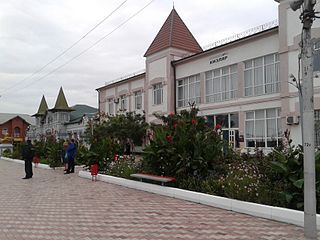
Kizlyar is a town in the Republic of Dagestan, Russia, located on the border with the Chechen Republic in the delta of the Terek River 221 kilometers (137 mi) northwest of Makhachkala, the capital of the republic. As of the 2010 Census, its population was 48,984.
Shamkhal, or Shawhal is the title for the rulers of Kumyk people in Dagestan and North-East Caucasus during the 8th-19th centuries. Since 16 century the capital of the Shamkhalate is Tarki, and the state is known as Shankhalate of Tarki.

The Sadz or Asadzwa, also Jigets, are a subethnic group of the Abkhazians. They are sometimes purported to have originated from the Sanigoi tribe mentioned by the Classic authors. In the 6th century, they formed a tribal principality, which later commingled with the Abasgoi, Apsilae and Missimianoi into the Kingdom of Abkhazia.
"Gazikumukh Shamkhalate" is a term introduced in Russian-Dagestan historiography starting from the 1950s–60s to denote the Kumyk state that presumably existed on the territory of present-day Dagestan in the period of the 8th to 17th centuries with the capital in Gazi-Kumukh, and allegedly disintegrated in 1642. However, In the 16th century's Russian archival sources Tarki is stated to be the "capital of Shamkhalate" and "the city of Shamkhal", while "Kazi-Kumuk" is mentioned as a residence. These facts contradict "1642 disintegration" date. Moreover, there is absolutely no source before 1950th containing the term "Gazikumukh Shamkhalate" or a statement that Gazi-Kumukh had ever been the capital of Shamkhalate. Historically, Shamkhalate is widely described as Tarki Shamkhalate or just Shamkhalate.

The Shamkhalate of Tarki, or Tarki Shamkhalate — was a Kumyk state in the eastern part of the North Caucasus, with its capital in the ancient town of Tarki. It formed on the territory populated by Kumyks, and included territories corresponding to the modern Dagestan and adjacent regions. After subjugation by the Russian Empire, the Shamkhalate's lands were split between the Empire's feudal domain with the same name extending from the river Sulak to the southern borders of Dagestan, between Kumyk possession of the Russian Empire and other administrative units.
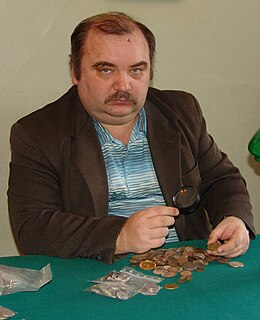
Alexander Vladimirovich Bykov is a Russian historian and ethnographer, one of the leading Russian specialists in numismatics. Publisher, founder of the first Russian private museum of political history, the Museum of Diplomatic Corps in Vologda, Russia; he is the author of multiple articles, books, and popular science publications.
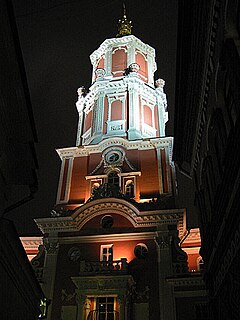
Freemasonry in Russia started in the 18th century and has continued to the present day. Russian Freemasonry pursued humanistic and educational purposes, but more attention is given to ethical issues. It was a spiritual community of people united in an effort to contribute to the prosperity of the Motherland and the enlightenment of the people living in it.

Alkon Distillery is one of the oldest enterprises in Russia, producing strong Russian alcohol: vodkas, nastoykas, nalivkas and balsams. The main principle of Alkon official policy is the alcohol production according to the classical technology that came from several centuries ago. It requires the use of natural raw material, without application of food colorants and aromatic substances.

Russian chronicles or Russkiye Letopisi are the main type of Old Russian historical literature. Composed from 11th to 18th centuries the Chronicles are one of the leading genres Russian literature and among the most extensive monuments to it.
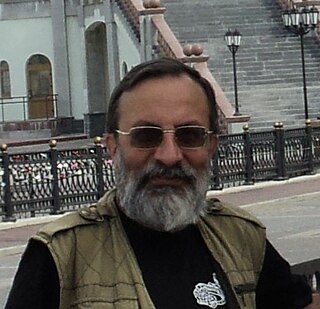
Vladimir Petrukhin is a Russian historian, archaeologist and ethnographer, Doctor of Historical Sciences, chief research fellow of the Medieval Section in the Institute of Slavic Studies in the Russian Academy of Sciences, professor of Higher School of Economics.
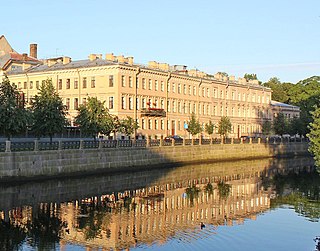
The Musin-Pushkin House is an historic building in Saint Petersburg, located at number 104 on the Moyka River Embankment. It is also known as "A. I. Musin-Pushkin's House", and was built during the 18th and 19th centuries. The building's present appearance dates from 1848.
Nnjjjbranches of the Sorokoumova-Glebov family. Eudoxia Lopukhina married Peter the Great. When Pyotr Lopukhin's son died childless, the family's princely title passed to Nikolai Petrovich Demidov-Lopukhin. The present Prince Lopukhin-Demidov is Nikolai Alexander Paul Demidoff born in 1976.

Arseny Dmitrievich Mironov was a Russian scientist, aerospace engineer, and aviator. He was one of the oldest researchers in aircraft aerodynamics and flight testing, a Gromov Flight Research Institute (GFRI) director from 1981 to 1985, a recipient of the Stalin Prize in 1948 and the USSR State Prize in 1976, and an honorary citizen of Zhukovsky.
"Utushka lugovaya" is an ancient Russian folk song.
Max Taitz was a scientist, an engineer, and one of the founders of Gromov Flight Research Institute (1941). He was a doctor of engineering, a professor, and a recipient of the Stalin Prize, and the honorary title of Honoured Scientist of the RSFSR (1961).
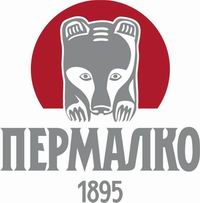
Joint-Stock Company Permalko is one of the leading distilleries in Perm and Perm Kray. The company is in the top 20 list of vodka and spirits producers in Russia.

Kizlyar Brandy Factory is a Russian producer of alcoholic beverages, located in Kizlyar, Dagestan. It is one of the five largest Russian cognac producers.

Vladimir Schneider is a Russian historian, Doctor of Historical Sciences. He is the author of more than 120 scientific works, among which 6 monographs. He is a professor in the department of universal and national history of Armavir State Pedagogical University. Worked as dean of the history department of ASPU from 1999 to 2011. The main directions of scientific work: the socio-cultural aspect of the history of the peoples of the North Caucasus; Soviet national policy in the North Caucasus of 1917 - the end of the 1950s; the history of the deportations, the stay at the special settlement and the rehabilitation of the North Caucasian peoples; historical and cultural integration processes in the North Caucasus; the history of the German diaspora in the Kuban; historical research methodology issues.
|journal= (help)|journal= (help)|url= value (help)(PDF) on 2018-12-29. Retrieved 2019-05-05.Cite journal requires |journal= (help)